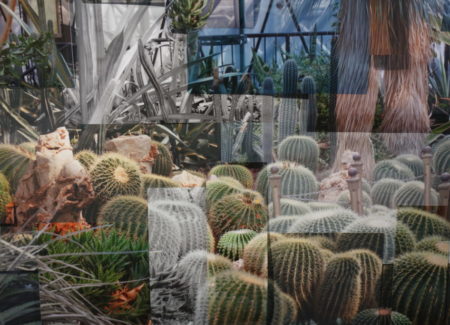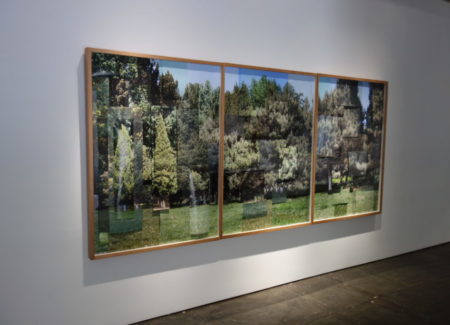JTF (just the facts): A total of 8 large scale photographic works, framed in light brown wood and unmatted, and hung against white walls in the main gallery space and the smaller side room. All of the works consist of collaged archival pigment prints made in 2017. The single panel works range in size from roughly 43×71 to 59×83; the triptych has three panels, each roughly 65×47. The works are available in editions of 3+2AP. The show also includes 1 installation (in the side room) consisting of 4 archival pigment prints in wooden frames and a backdrop of wallpaper. It was made in 2017 and has dimensions of 139×237. (Installation shots below.)
Comments/Context: At this point in the long history of the medium, photographic montage is, in large part, a well understood genre. In most cases, to build a photomontage, individual photographs are used as component parts of a larger aggregate composition, the various fragments pasted, glued, or otherwise stuck together into one singular whole. We can go back to Cubism as a starting place for the underlying multi-perspective ideas behind this approach, and can then follow through to the varied work of David Hockney, Thomas Kellner, and Sohei Nishino (among many others) to see how contemporary artists have reinterpreted this process of visual accumulation. And if we then bridge to the digital realm, a parallel stitching and merging process was made famous by Andreas Gursky in the 1990s, and these sophisticated compositing techniques have been further adopted and adapted by literally countless others since then.
Ji Zhou’s approach to photographic montage twists the aesthetic dials in two new directions. His first reconsideration is a conceptual one. Instead of using the montage process to gather and interweave multiple perspectives of a single moment, he has used it to harmonize related views of the same place across time. Zhou’s works merge together dozens of images taken from a fixed location over the course of a single day, the changing patterns of light and activity from morning to night providing plenty of variation, even with the perspective remaining the same. Skies darken at twilight, neon lights spring to life, midday sun blanches the sidewalks, and apartment lights blink on from dozens of stories high. Up closer, colors shift from warm to cool and back again, tinting the surroundings in various shades of subtle difference.
Zhou also alternates between shooting in black and white and color, so each overlapping fragment has different options for brightness, tonality and hue; he’s even thrown in a few negative reversals as well to further complicate the aesthetics. His finished city vistas and botanical garden views seem to oscillate through time, simultaneously showing us conflicting and contradictory slices of many moments collapsed into an uneasy hybrid.
A second formal innovation finds Zhou staying firmly rooted in physical hand-crafting, while overtly exploring both sculptural space and textural nuance. Instead of flattening his images down into a single uninterrupted plane, Zhou hinges them along the top edge, allowing them to hang freely. The results are something akin to a burbling waterfall of paper, with small undulations occurring in repeated strips down the surface of the work. The strict geometries of the paper fragments are particularly successful when they match the underlying content, from the rectangles of a urban buildings to the panes of glass in the greenhouse. And when the gallery lights are on, the hanging papers create both shadows and depth, as the small space underneath the fragmented prints billows outward.
Zhou’s interest in texture comes through in his paper choices – his piecepart images are alternately printed on glossy, matte, and fancy calligraphy stocks, so as the viewer scans across the apartment blocks of the city or a cluster of cacti in the botanical garden, the saturations shift based on the substrates. These constant changes of texture further animate the works.
Zhou’s previous project used paper maps as raw material for sculptural mountain vistas, and the idea of mapping clearly continues here. Zhou is, in a sense, systematically “mapping” these scenes, breaking them down into smaller, almost individual abstractions like tiles, which he has then used to build up something robustly three dimensional, both physically in terms of the many layers of paper and more conceptually in the incorporation of the element of time. A static map usually can’t reconcile the passing of time (it’s one of the variables that is routinely abstracted out), but Zhou’s image maps reintroduce ongoing change, giving his works a sense of shifting fluidity.
In the end, it is the restlessness of Zhou’s images that draws us back in. While they purport to show us things we already understand (what could be more obvious than a city view?), they never quite resolve, giving the certain a freshening dose of uncertainty. Zhou asks us to see his cities and gardens as something akin to living, breathing entities, places that are constantly evolving even over the course of just one day. Pushing photography to incorporate the subtleties of time is always a challenge, but Zhou’s efforts deliberately expand the notion of a single “decisive moment” frame into something altogether more cleverly turbulent.
Collector’s POV: The works in this show range in price from $10000 to $26000 based on size. Ji Zhou’s work has little secondary market history at this point, so gallery retail likely remains the best option for those collectors interested in following up.














